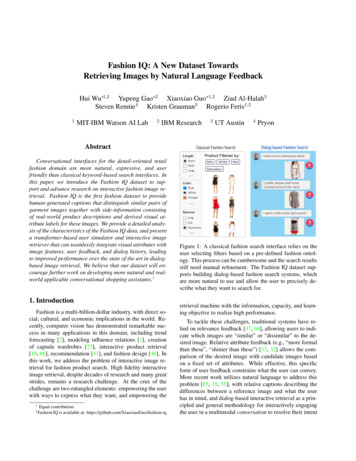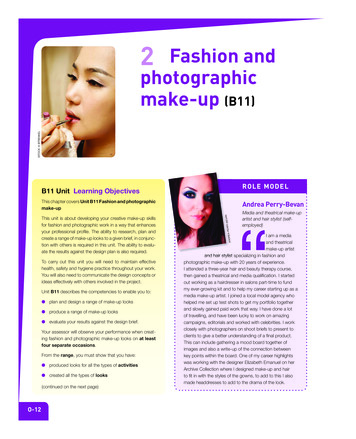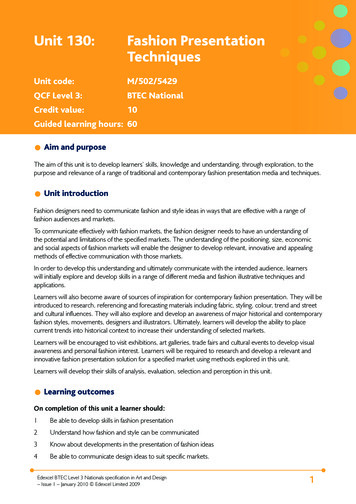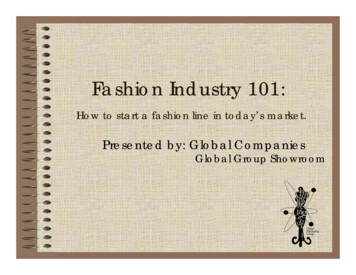
Transcription
PULSE OF THE FASHION INDUSTRY
PULSE OF THEFASHION INDUSTRY
Publisher: Global Fashion Agenda & The Boston Consulting GroupCopywriter: John Kerr, John LandryGraphic Designer: Daniel SiimArt director: Thomas BlankschönCover photo: Copenhagen Fashion WeekPhotos:Machines documentary - Rahul JaanI:CO/SOEX GroupCopenhagen Fashion WeekGreenpeace - Jeff Lau, Lu Guang, Andri Tambunan, Peter Caton, RezzaEstily, Liu FeiyuePrint: KLS PurePrint A/S2017 Copyright Global Fashion Agenda and The Boston ConsultingGroup, Inc.All rights reserved. Reproduction is strictly prohibited without prior writtenpermission from the authors.Every effort has been made to trace the copyright holders for thispublication. Should any have been inadvertently overlooked, GlobalFashion Agenda and The Boston Consulting Group will be pleased to makethe necessary changes at the first opportunity.AcknowledgementsThe authors would like to thank the Sustainable Apparel Coalition forproviding the data that made it possible to take the Pulse of the FashionIndustry, and the colleagues who contributed to this report: Jason Kibbey,Baptiste Carrière-Pradal, Julie Holst and Betsy Blaisdell.A big thanks goes out to all the respondents who participated in the PulseSurvey.In addition, we would like to thank all the experts that donated their timeand expertise to make this report come to life, including Hendrik Alpen,Michael Beutler, Marc Binder, Marie-Claire Daveu, Sabine Deimling, AnnaGedda, Linda Greer, Sarah Jastram, Leslie Johnston, Ivanka Mamic, WilliamMcDonough, John Mowbray, Emmanuelle Picard-Deyme, Irene Quarshie,Harsh Saini, Mark Sumner, Géraldine Vallejo, Dilys Williams and Åsa ÖstlundThe authors would also like to thank all the members of the BCG fashionand sustainability community for their contribution to this report, includingOlivier Abtan, Christine Barton, Filippo Bianchi, Bharat Khandelwal, StefanRasch and Christina Synnergren.This report is Cradle to Cradle Certified and environmentally neutral. Thepaper and ink contains no harmful chemicals or heavy metals, and are 100%biodegradable. Printed by KLS PurePrint A/S, a 100% sustainable printinghouse.GLOBAL FASHION AGENDAGlobal Fashion Agenda is a global leadership forum on fashion sustainability founded in 2016 and anchored around Copenhagen Fashion Summit, the world’s principal event on sustainability in fashion forindustry decision-makers. Global Fashion Agenda advances a yearround mission to mobilize the international fashion industry to transform the way we produce and consume fashion, for a world beyondnext season. In partnership with sustainability pioneering industryleaders including Kering, H&M, Target, Li & Fung and Sustainable Apparel Coalition, Global Fashion Agenda sets the agenda for the industry on the most critical environmental, social and ethical issues, andadvocates for a collective industry focus on the largest opportunities.Global Fashion Agenda is a not-for-profit initiative. For more information, please n-agendaTHE BOSTON CONSULTING GROUPThe Boston Consulting Group (BCG) is a global management consulting firm and the world’s leading advisor on business strategy. Wepartner with clients from the private, public and not-for-profit sectors in all regions to identify their highest-value opportunities. Ourcustomized approach combines deep insight into the dynamics ofcompanies and markets with close collaboration at all levels of theclient organization. This ensures that our clients achieve sustainablecompetitive advantage, build more capable organizations, and securelasting results. Founded in 1963, BCG is a private company with 85offices in 48 countries. For more information, please visitwww.bcg.comG LO B A LFA S H I O NAG E N DA
INTRODUCTION / PAGE 1Towards a Better Fashion IndustryCHAPTER 1 / PAGE 7The Case for Change is IndisputableCONTENTSCHAPTER 2 / PAGE 25Pulse Check of the IndustryCHAPTER 3 / PAGE 69A Landscape for ChangeCHAPTER 4 / PAGE 105A Call for Collaboration and Innovation
INTRODUCTIONAbout the reportTOWARDS A VISION OFA BETTER FASHION INDUSTRYThe authors of this report—The BostonConsulting Group (BCG) and GlobalFashion Agenda (GFA)—have developed acommon fact base on the health of the industry, and have evaluated and quantifiedthe overall opportunity for sustainabilityin fashion. GFA and BCG worked in closecollaboration with GFA’s strategic partnersthat have acted as a sounding board, comprising H&M, Kering, Li & Fung, Target, andthe Sustainable Apparel Coalition (SAC).Further, the SAC has acted as an exclusivedata provider through the Higg Index.BCG has analyzed this data in depth, andhas complemented the input to get arepresentative metric on sustainability infashion: the Pulse Score.PULSE OF THE FASHION INDUSTRYThe fashion industry has a clear opportunity to act differently, pursuing profit and growth while also creating new value for society and therefore for the world economy. It comes with an urgent need to place environmental, social, and ethical improvements on management’s agenda.In recent decades, the fashion industry has been an engine for globaldevelopment. One of the world’s largest consumer industries,1 generating 1.5 trillion in annual apparel and footwear revenues in 2016,2 it employsaround 60 million people along its value chain.3To continue the growth trajectory, the fashion industry needs to address its environmental and social footprint. The earth’s natural resources are under pressure, and the fashion industry, although not the mostobvious contributor, is a considerable one. Social conditions—also in thefashion industry—are far from those set forth in the United Nations’ goalsfor sustainable development. With current trajectories of production andconsumption, these pressures will intensify by 2030 to the point of threatening industry growth itself.With resources becoming even scarcer, the industry will face risingcosts from labor to materials and energy. Based on conservative projections, fashion brands’ profitability levels are at risk in the range of at least 3percentage points if they don’t act determinedly, and soon.The facts show a clear need for acting differently. The good news isthat by changing practices, the industry can both stop the negative impactand generate a high amount of value for society, while also protectingprofitability. We estimate that the world economy would gain about 160billion annually if the fashion industry would successfully address thoseenvironmental and social issues.As of today, the sustainability ‘pulse’ of the industry is weak. The newly developed global Pulse Score, a health measure for the sector (see page28 for more details), is only 32 out of 100. The industry is not yet where itcould and should be. The spread of performance is also quite large. Thebest performers on sustainability are the very big players as well as somemid-sized, family owned companies, while over half of the market, mainlysmall to medium-sized players, has shown little effort so far. The rest of theindustry is somewhere in between. This is confirmed by the Pulse Survey(further information on pages 35/36), where two-thirds of polled fashionexecutives have not made environmental and social factors guiding principles for their companies’ strategy.Fashion brands with targeted initiatives will be best placed to improvetheir environmental and social footprint and counteract the rising costs ofapparel production. They will pull ahead of their competitors with innovative ways of doing business and efficient production techniques that minimize the use of water, energy, and land, as well as hazardous chemicals.By realizing better working conditions and improving workers’ safety, theywill minimize their operational and reputational risks and create significantvalue for themselves and the world economy. These initiatives will improvethe overall industry Pulse, raising the average and creating inspiring bestpractices for the low performers to learn from.However, even if the entire industry caught up to the best practicefront-runners, it would not be enough. Under optimistic and ambitious assumptions, only less than half of the 160 billion could be captured.4 Theindustry needs coordinated action beyond today’s solutions. This reportexplains the size of the challenge and the need for innovation, collaboration and supporting regulatory action to close the gap.2
This first edition of the Report on the Pulse of the Fashion Industry exposes the challenges in a number of sustainability impact areas andalong the industry’s value chain, from design and development to end-oflife for apparel and footwear. It aims to provide transparency on the industry’s stance in terms of its environmental, social, and ethical footprints—topics that have been much debated, yet without a common baseline andframework against which to evaluate change. It also reviews ways in whichthe industry can maintain and even strengthen its profitability despite thepressures of rising costs.The overarching objective of the report is to provide a direction andguidance towards a better fashion industry. As a starting point, the reportprovides a common fact base on the current sustainability performance ofthe industry. Based on that it lays out a Landscape for Change and presents pragmatic, concrete, and economical actions that are already available for producing palpable change. The report promotes collaboration andinnovation as main drivers to accelerate change.cal areas for improvement; from bodies such as NGOs, industry associations, and consortia in coordinating and driving the cross-industry andcross-functional collaboration to propel change; and from regulators inamplifying change with supportive incentives—or in interfering with strongdictates when the industry moves too slowly.All this is more easily said than done.There is, however, every possibility that change can happen in a shorttime. The fashion industry has in-built advantages: the creativity that is itsmost emblematic trait and the public admiration it continues to enjoy. Supported by disruptive technologies, fashion has the talent, the networks,the funding, and all of the resources it needs to transform itself. Now is thetime to start doing things differently.BOLDER LEADERSHIP NEEDED NOWWhat will it take to tackle the changes necessary to improve the industry’s standing—and to safeguard its profitability? First, it is importantto acknowledge that many laudable efforts are already being made acrossthe industry. Individually, many companies are striving to optimize business practices. Collectively, too, many initiatives have been launched withthe goals of educating consumers, striving for substantial improvements,building broad industry networks dedicated to environmental, social andethical objectives, and more.There is no shortage of non-government organizations and privatefoundations to provide education, incentive, and oversight. There are alsoworking groups, forums, and conventions, with the Global Fashion Agenda’s annual Copenhagen Fashion Summit as the world’s leading event onsustainability in fashion.5 Much effort has gone to develop transparencyindexes as standard supply chain measurement tools, such as the Sustainable Apparel Coalition’s (SAC) Higg Index that is already in use by manycompanies. These enable all industry participants to understand the environmental and social impacts of making and selling their products andservices.6All of these well-staffed and well-thought-out initiatives have helpedcompanies make real progress in sustainability and built a foundation forfuture improvement. Despite those efforts, the pulse of the industry isweak. Therefore we advocate for a consolidation and realignment of efforts and resources towards high impact levers, with fewer and strongerinitiatives. It’s now time to work for the broad commitment necessary tomake the extensive, industry-wide changes required. We need to go beyond campaigns driven by single entities that yield incremental results. Individual fashion brands cannot drive major changes on a large scale acrossvalue chains, impact areas and geographies. And individual governmentscannot set the regulatory framework for a global industry.We need well-orchestrated, system-wide actions that involve a broadcoalition of stakeholders. That requires bold leadership: from fashion businesses in prioritizing, collaborating and committing to actions on criti-3INTRODUCTIONPULSE OF THE FASHION INDUSTRY4
CFW
1CHAPTERTHE CASE FOR CHANGE IS INDISPUTABLEThe fashion industry is highly fragmented, with thousands of actorsinvolved and one of the most complex global production networks andsupply chains. There is not a standard path for the cotton produced in onecountry, spun in another, dyed and processed in a different one and converted into a garment in a factory far away from the store. And often, thereis no view of the ‘real cost’ incurred.It is challenging then to truly gain an understanding of what the critical sustainability issues are and to fully grasp the magnitude of the valueat stake.In fact, there is a lack of reliable facts to guide action. It is not enoughto respond to unsubstantiated statements such as “The global fashionindustry is the second most polluting industry in the world”. Data andagreed-upon links between cause and effect are what spark ideas, createconviction, and sponsor action. With this report, GFA and BCG intend tostart building a frame of reference that transcends misconceptions and forthe first time offer a common baseline of facts and ideas, empowering thefashion industry to act.This chapter provides global environmental and social facts at aglance and looks at how they relate to the fashion industry. It also presents a projection to 2030 that assumes the fashion industry continueson its current trajectory of production and consumption. To highlight theopportunity, we conclude by calculating the value at stake for the worldeconomy and arguments for businesses to start acting now.2030: 8.5 BILLION PEOPLE WILLREQUIRE CLOTHINGIf the global population rises as expected to 8.5 billion people by20307 and the GDP per capita grows at 2% per year in the developedworld and 4% in the developing world,8 GFA and BCG project that theoverall apparel consumption will rise by 63%, from 62 million tons today to102 million tons in 20309—an equivalent of more than 500 billion T-shirts.Concurrently, soaring demand for apparel—much of it from developingnations—will see the annual retail value of apparel and footwear reach atleast 2.0 trillion by 2030 (an over 30% increase of 500 billion betweennow and then).10We explore below how the growth of the industry—in terms of valueand volume—comes with increased environmental and social costs. Weconsider these mounting costs from the global and the industry perspective.To gain a sense of the importance of each impact area, GFA and BCGhave placed a monetary value on each externality. This enables a transparent illustration of how much value is at stake for the world economy—representing human economic activity, social and natural capital—in a tangible and comprehensive way. In this report we present exemplary evidencefor the economic viability of sustainability initiatives. Estimating the fullbusiness opportunity for individual companies implementing sustainablepractices will be a topic of future editions of the Pulse report. This assessment will be carried out in cooperation with corporate frontrunners on thesubject.PULSE OF THE FASHION INDUSTRY8
Exhibit 3Planetary boundaryProjected Environmental ImpactsIncreasing Fashion Consumption is Creating Further Environmental StressProjected global fashion consumption1 (Million tons)2015102Distance from planetary boundaryPOSRU63%ECLCYLand use62Water consumptionNITROGEN CYCLEChemicals usageWaste creation2015Consumed water(billion cubic meters)EnergyemissionsEmissions of CO2(millions tons)ChemicalsusageChemicals management(Pulse Score in %)37WastecreationProduced waste(million tons)92791,715118 50%2,791 63%Pulse Scorenot to beprojected148 62%20301. Fashion consumption of apparel and footwearSource: BCG analysisExhibit 1 The Planetary Boundaries 2015Environmental impactSPOHEnergy emissionsWaterconsumption2030The Planetary Boundaries HaveAlready Been BreachedENVIRONMENTAL PRESSURES PUT 110BILLION VALUE AT STAKEWhen we look at the planet from the perspective of several planetary boundaries, delimiting an environmentally sustainable safe operating space for humanity, as defined by a group of earth environmental scientists led by researchers from the Stockholm Resilience Center and theAustralian National University, it becomes clear that the planet is alreadyfacing significant tensions based on human activity.11,12 According to theseresearchers the planet is already beyond its safe operating space in termsExhibit 2 The Planetary Boundaries 2030of climate change, waste pollution, changes in land use, and biochemicaloutput.13,14 (See Exhibit 1.) That means we face increasingly higher risk ofIn 2030, the Planetary Boundaries Will BeEven Further Exceededdestabilizing the state of the planet,15 which would result in sudden and irreversible environmental changes with potentially large damaging impacton the world economy.PSPOHOAlthough the harm is, of course, not all due to the fashion industry,SRUECLCYthe industry’s present linear business model is an obvious contributor tostress on natural resources.If production and consumption of apparel and footwear follow theircurrent trajectories, increasing by another 63%, fashion’s environmentalNITROGEN CYCLEfootprint will continue to contribute to the negative impacts on the planet.(See Exhibit 3.)The additional strain of an expanding environmental footprint can beobserved on a number of impact areas, specifically water use, CO2 emissions, use of chemicals, and generation and disposal of waste.Given that the natural resources of the planet are already burdened,the projected increase in the industry’s environmental footprint will exacerbate the situation. (See Exhibit 2.) In the worst case, the fashion industrywill face distinct restrictions on one or more of its key input factors, leavingit unable to grow at the projected rate and in the long run unable to continue under its current operating model.To understand the magnitude, context, and opportunities related toNote: Illustration adapted from UN EnvironmentProgramme, Rockström et al. and Steffen et al., representingtoday's statusSource: BCG analysis; UN Environment Programme (2012);Rockström et al. (2009); Steffen et al. (2015)9each area of environmental impact, it is useful to look at each in moredetail.CHAPTER 1PULSE OF THE FASHION INDUSTRY10
Water ConsumptionAlthough on average, global freshwater use has not yet exceeded itsplanetary boundary16 freshwater access is unevenly distributed across theplanet. Certain areas of the world (e.g., North Africa, the Middle East, andSouth Asia) already live in a state of near-permanent water stress.17The volume consumed by the fashion industry today is already largewith nearly 79 billion cubic meters—enough to fill nearly 32 million Olympic-size swimming pools. GFA and BCG anticipate that water use will increase by 50% by 2030,18 which is critical, because some of the main cotton-producing countries such as China and India are located in areas thatare already suffering from high or medium to high levels of water stress.19Those levels are projected to become even more severe, as the shortfallbetween demand and supply of water is projected to reach 40%20 by2030. Thus, as water scarcity becomes more extreme, cotton-growing nations and the fashion industry may face the dilemma of choosing betweencotton production and securing clean drinking water.Estimating the value for the world economy (see Impact Area Overview on page 21/22 for more detail) of the 39 billion additional cubic meters expected to be consumed annually by 2030,21 results in 32 billion atstake per year. That is the potential benefit to the world economy if thefashion industry can find ways to consume no more water than it doestoday. The most significant water use occurs during the production of rawmaterials—notably in cotton cultivation—but many aspects of textile processing are also water intensive. Additionally, consumers are responsiblefor further consumption as they wash their clothes.tion consumes an estimated 16% of all insecticides and 7% of all herbicides.30 Finally, organic and inorganic toxic substances (such as mercuryand arsenic) discharged to waterways from processing plants damage theenvironment.31 The impacts to human health of water pollution include toxins building up in the body, possibly leading to cancers, acute illnesses, orother conditions.To approximate the monetary impact, these effects are tied to occupational illnesses attributed to carcinogens and airborne particulates (seeImpact Area Overview for details, page 21/22). By eliminating such healthimpacts due to poor chemical management by 2030, an annual value ofaround 7 billion can be gained.Waste CreationToday, humankind produces 2.1 billion tons of waste per year.32 Interms of annual ecological footprint, the world’s population already produces more than 1.6 times what the earth can absorb in the same timeframe.33Assuming today’s current solid waste34 during production and atend-of-use, the industry’s waste will increase by about 60% between 2015and 2030, with an additional new 57 million tons of waste generated annually.35 This brings the total level of fashion waste in 2030 to 148 milliontons—equivalent to annual waste of 17.5 kg per capita across the planet.36The vast majority of clothing waste ends up in landfills or is incinerated;globally, only 20% of clothing is collected for reuse or recycling.37Energy EmissionsThe level of atmospheric CO2 already today exceeds by about 20%what is considered safe, according to the latest earth system research.22,23The industry’s CO2 emissions are projected to increase by more than 60%to nearly 2.8 billion tons per year by 203024—the equivalent of emissionsproduced by nearly 230 million passenger vehicles driven for a year, assuming average driving patterns.The value opportunity at stake to the world economy of improvedenergy management in the fashion industry is the largest in magnitudeacross all impact areas with 67 billion, representing effects such as shifting climate patterns. Because some of the fashion sector’s primary manufacturing locations are particularly vulnerable to climate change and risingsea levels, large benefits can be reaped for both the world economy andthe suppliers to the fashion industry. The industry’s greatest impacts onthe climate is from processing, followed by the use of apparel and the production of raw materials.25,26THE FASHION INDUSTRY WILL FACERESTRICTIONS ON ONE OR MORE OF ITSKEY INPUT FACTORS, RISKING GROWTHAT THE PROJECTED RATEA large opportunity for value creation awaits the world economy ifthe fashion industry manages to convert textile waste into raw materialsthrough the use of advanced recycling techniques (discussed in moredepth in chapter 3). But this type of recycling technology is not yet available for a broad range of fibers and it has yet to be proved economicallyviable at scale. Therefore, the current value is based on pure waste reduction along a linear value chain. Consequently, the opportunity to theworld economy is modest at around 4 billion per year in 2030—althoughunder a circular model of production and consumption, this value wouldbe manifold higher.Chemicals UsageThe level of biochemical flows, represented by the flow of phosphorus from fertilizers to erodible soils, already exceeds the safe operatingspace by more than 220%.27 Through cotton production, the fashion industry is a large user of fertilizers, with cotton consuming 4% of nitrogenfertilizers and phosphorous globally.28 Excessive use of fertilizers can leadto runoff from the land into waterways. The negative effects include algalblooms depleting oxygen in the water.29 Further, although the cultivationarea of cotton covers only 3% of the planet’s agricultural land, its produc-11CHAPTER 1PULSE OF THE FASHION INDUSTRY12
Exhibit 4The Mandate Is Clear: The Fashion Sector Has theOpportunity to Drive Improvements60-80%34%SHARE OF EXPORTS INCOUNTRIES SUCH ASBANGLADESH OR CAMBODIAOF THE TOTAL EMPLOYMENT INMANUFACTURING ACROSSKEY ASIAN PRODUCTION COUNTRIES50%COMPANIES ON AVG. SPENDOVER1. UN figure given forsovereign states0.2%OF WORKERS ARE NOT PAIDTHE MINIMUM WAGE INCOUNTRIES LIKE INDIA ORTHE PHILIPPINESMINIMUM WAGESIN THE INDUSTRYAREOF WHAT CAN BECONSIDERED ALIVING WAGE½13THE INDUSTRY HASON AVG.5.6NONCOMPLIANCETO MINIMUMWAGES CAN BEAS HIGH AS87%CHAPTER 1OF SALES ON COMMUNITYSPENDING, WHILE THEUN PROPOSES 0.7% IN ITSDEVELOPMENT GOALS¹FOR WOMEN WHILEIT IS 27% FOR MEN INPAKISTANPULSE OF THE FASHION INDUSTRYINJURIES PER 100 WORKERSPER YEAR, WHILE INSUPPLIERS' FACTORIES OFA LARGE SPORTS GOODSMANUFACTURER NUMBER ISONLY 2.514
Exhibit 5 Projected Social ImpactsLabor PracticesAs recently as 2015, 10% of the world’s workers and their familieswere living below the international poverty line of 1.8 (in purchasing power parity) per day.46 If current patterns persist, 4% to 6% of the world’spopulation will still be below the poverty line in 2030, falling significantlyshort of the UN Sustainable Development Goal of zero poverty by 2030.47The fashion industry is not solely responsible for eradicating all povertyand hunger, but as a major employer and driver of economic prosperityin many developing countries, it is well placed to make a difference andimprove social conditions.In many Asian nations, the sector’s minimum wages are less than halfof what can be considered a living wage.48 The gaps between minimumwages and living wages are equally staggering in Eastern Europe and Turkey.49 This issue is heightened with the many factories that fail to complywith their countries’ minimum wage laws. For example, in major textilemanufacturing countries like India, the level of noncompliance reaches51%.50 If there is no systematic, concerted push to respond to those realities, more than one-third of workers in the sector globally are projected tobe paid less than the minimum wage by 2030.51At a global level, gender equality has an especially long journeyahead, with 52 countries lacking constitutionally guaranteed equality. Further, the United Nations views gender equality as “not only a fundamental human right, but a necessary foundation for a peaceful, prosperousand sustainable world.”52 This gender inequality also manifests itself in thefashion industry, where women are particularly vulnerable to low wagelevels due to persistent gender pay gaps. (In India, women face a pay gapof 39% compared with men for the same job; in Pakistan, that figure is asgreat as 48%.)53 Further, women are more likely than men to be paid below the minimum wage. For instance, in Pakistan’s garment sector, 87% ofwomen are paid less than the minimum wage, while the figure is 27% formen.54 This is critical, as women often constitute the majority of the apparel, footwear, and textile workforce—as much as 74% to 81% in Cambodia,Vietnam, and Thailand.55The topic of labor practices encompasses a broad range of socialissues such as compensation, working hours, worker treatment, workerrights, gender equality, and child labor. In order to provide the broadestrepresentation of this impact area, the focus in this part of the report iswages. Paying fair wages is a key area for the industry to act on. Becausea large gap exists between minimum wages and living wages (see ImpactArea Overview on page 21/22 for details), the first step could be for theindustry to aim for ‘extreme compliance’ to minimum wages (paying 120%of the legal minimum) as reported by ILO.56Currently 14 million workers are paid below this 120%-threshold. Ifwages are not increased, that number is projected to exceed 21 million by2030.57 By not increasing the number of workers being paid less than thislevel, while maintaining the projected growth of the industry, there is anannual value opportunity at stake of approximately 5 billion by 2030.Social Issues Will Intensify with Increasing Fashion ConsumptionProjected global fashion consumption12015102LaborpracticesWorkers paid less than 120%of min. wage2 (millions)14Health& safetyNo. of recorded injuries(millions)1.4Community& ext. engangementForegone community/ext. spending ( billions)203021 52%Social impact63%62201571.6 7%9 35%20301. Fashion consumption of apparel and footwear2. The authors of this report do not recommend 120% min.wage as representative of a living wage; level of 120% min.wage taken to show general insufficiency of min. wage levelto make a living; further the taken threshold is advantageous due to data availability in ILO reports on min. wagecomplianceLand UseThe area of forested land that has been cleared for various uses, including land intended for cotton cultivation, has exceeded the safe operating space by 17%.38,39 By 2030, it is predicted that the fashion industrywill use 35% more land for cotton, forest for cellulosic fibers, and grasslandfor livestock—altogether over 115 million hectares that could be used togrow crops for an increasing and more demanding population or to preserve forest.40 A global population of 8.5 billion in 2030 will require a 60%increase in agricultural production in order to feed everyone,41 which, aswith the case of water, will result in the dilemma of whether to produceraw materials for textiles or to grow food for an increasing population. Thisis a strong incentive for the fashion industry to consider the impact of itsraw materials on land use and to shift the material mix toward less land-intensive inputs. The scarcity of arable land might lead to higher cost of landor eve
Nov 04, 2020 · THE BOSTON CONSULTING GROUP The Boston Consulting Group (BCG) is a global management con-sulting firm and the world’s leading advisor on business strategy. We partner with clients from the private, public and not-for-profit sec-tors in all r











